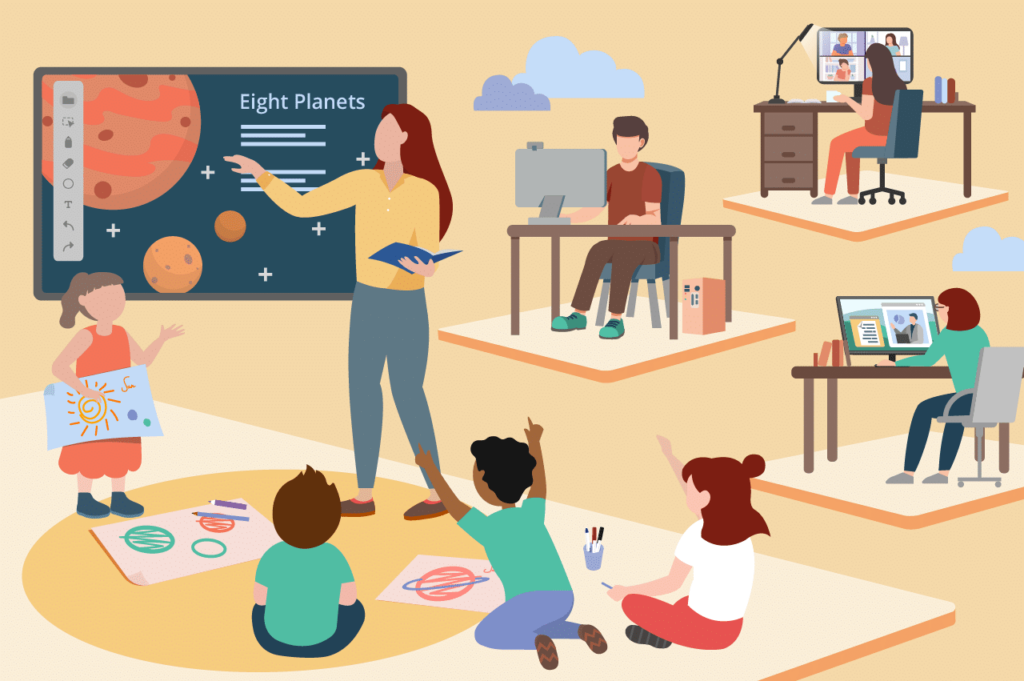Online education is difficult for most children even if they use different services like editius.com to make the study process easier. So, we have some trends in education that help you in the future.
1. Development of soft skills

Among the Top 10 skills we will need in 4 years: critical thinking, analytical skills, problem-solving skills, initiative, innovation and more. It is important to integrate these competencies with the subjects now. To facilitate the work of teachers in this direction will help quality resources and textbooks, which not only contain tasks for the development of soft skills, but also have a clear explanation for the teacher how to do it well and motivate students to develop. National Geographic Learning textbooks will help you with this.
2. Personalization of education process
The principle “Students in the learning center” is understood differently. Some speak of a corrupt generation who are allowed to do anything, while others rethink not only the role of students but also their own. The teacher becomes a manager who analyzes the interests and motives of students and integrates them with learning objectives. Some people find it important to prepare for the exam, while others are looking for a tool to connect with the world in English.
It is difficult to combine all the interests and motives in a class with 25 students, but a well-designed course will facilitate this task. Students should be active: express their opinions about various events and compare themselves and their lives with the information in the textbook and be confident in the quality of preparation for exams.
Have you ever noticed the questions that accompany the Close-up, 2nd edition course? Students reflect on and express their attitudes toward different events or stories. Teenagers want to be heard. Give them that opportunity. Together with a thorough preparation for the exam, this course is a better solution to the problem of personalization of learning in high school. Students have access to all audio and video and word lists, so they can study at home, watch videos they like, or repeat material before the exam. Also students have one more opportunity to give some assistance with resources when they can just write DoMyHomeworkNow.com.
3. Education using project

And what about projects – it’s not just a task to draw a picture or make a presentation?
Just imagine! Each topic of the textbook turns into an interesting study or journey. Each lesson we add new knowledge to a key topic, and at the same time we practice reading, listening, speaking and writing. Students learn on the basis of interesting material, we seamlessly weave geography, science and other subjects into lessons. At the end of the topic there is enough knowledge to complete the final project work.
4. Nurture of students as citizens of the world
Such lessons are available to you, choose NMC Wonderful World for students in grades 1-6 and turn lessons into amazing discoveries from the first grade.
We are constantly moving in the direction of globalization and this cannot be denied. Today, our students don’t just watch foreign movies, they follow bloggers, celebrities, and even interact with peers from different countries during computer games, all without leaving their own room.
Teachers, in turn, can use this trend to teach children to understand and respect other cultures, to explain the importance of perceiving others as individuals, regardless of their race.
And where, if not in foreign language lessons, are the most favorable conditions for this? Encourage students to share examples of communication with foreign friends. Add texts about real people and real events.
Feedback from teachers, who do it constantly, speaks of the fact that such materials are almost the only thing that motivates teenagers to learn.
5. Blended learning

This method combines online and offline learning, so it motivates students, allows them to learn continuously and effectively organizes the process. For example, on the English Channel resource you can find short stories on various topics and interesting exercises that will be a great tool for blended learning. More about why you should use blended learning in learning English, here.
6. Mobile learning
For example, these applications offer a huge choice for learning. You can download apps to Google Play, the Apple App Store, or use a QR code. The Tri Pro English Website and Mobile Apps resource helps students practice listening with free, high-quality, split-level recordings.
7. Gamification

You can use both online and offline tools for this method. For example, in the classroom you can play the game: “Teacher vs. class”: students must follow the rules set by the teacher. Each time a student follows a rule, the group receives an extra point. If he violates, the teacher receives a point. If the group wins, they may be rewarded with a longer break or fewer homework assignments.
Learn Languages with Ruby Rei immersing students in an interactive adventure game. They must use their language skills to negotiate, cooperate and build friendships to escape from a forgotten planet at the edge of the universe.
8. Learning with the help of the body
It is an educational method based on the idea that learning is not just memorization. It involves the use of mind and body, collaboration, discussion and research. With this method, students are involved emotionally, intellectually, physically and socially. Research shows that participants are more likely to evaluate or describe a concept when it corresponds to the action taken by the participants. This method is often used for children, but is also used in higher education. For example, scientists have developed a game in which students, using certain movements, learn modal verbs.
9. “Learning in a complex world”

The scenarios that teachers encounter in some course materials may seem simplistic and unrealistic. For example, on Fast Track 5 you can find real video and audio to convey the real world to students. It helps students apply the communication skills needed in the 21st century. National Geographic’s adult-focused Perspectives uses real-life TED stories and conversations to motivate students to think critically and creatively.
10. Multi-literacy and transitivity
In global communities where English is the common language of communication alongside other languages, knowledge of other languages is an advantage. Instead of reducing students’ use of their native language, teachers encourage students to use their own languages. This requires complex social and cognitive skills. Now classes in English alone are gradually a thing of the past.








